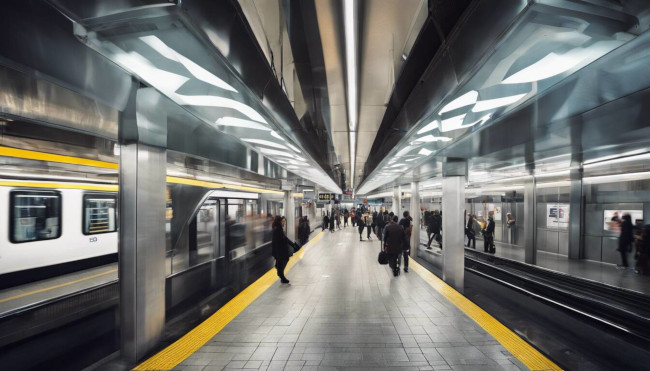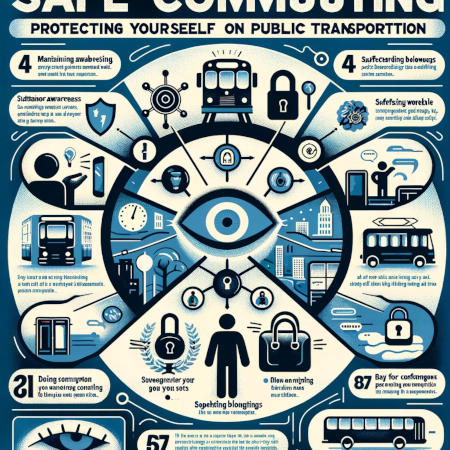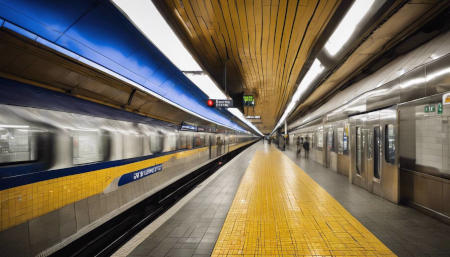Protecting Yourself on Public Transportation

Navigating public transportation securely starts with understanding your route. This includes knowing the stops, schedules, and key details about the area to avoid ending up somewhere unfamiliar or unsafe. Perhaps another aspect of safety you hadn't considered is pre-planning; having a solid plan in place can help tremendously in decreasing potential risks during your commute. Now, let's delve into the specifics of pre-planning for secure public transport.
Protecting yourself on public transportation is essential. Always be aware of your surroundings, keep your belongings secure, and consider carrying a self-defense device such as pepper spray or a personal alarm for added security and peace of mind. Additionally, familiarize yourself with the route and schedule, and try to sit near the driver or conductor if possible.

Pre-planning for Secure Public Transport
One of the simplest but most effective ways to ensure your safety while using public transportation is to research your route ahead of time. Familiarize yourself with public transport routes, stops, and schedules to reduce the likelihood of getting lost and ending up in unfamiliar or potentially unsafe areas. By knowing the layout of the routes and schedules, you can feel more confident and in control during your commute.
For instance, let's say you take the same route every day from work. Knowing where each stop is located and at what times the buses or trains arrive gives you a sense of familiarity and predictability. If something unusual were to occur, such as a delay or detour, you are better equipped to handle it when you have a good understanding of your regular routine.
Furthermore, notifying a trusted friend or family member about your travel plans before setting off is an extra layer of security that can provide peace of mind for both you and those who care about you.
Notify Someone
It is always a good idea to inform someone you trust about your travel plans, including the route you intend to take, expected arrival time, and any changes in your schedule as they occur. This not only gives you an added sense of security but also ensures that someone knows your whereabouts should anything unexpected happen during your journey.
Being prepared is much like logging off your computer before heading out. It's a small additional step to ensure everything stays safe.
Imagine something happens, like if the bus breaks down or runs into an issue mid-route. Having someone aware that you should have reached your destination by now could mean they might check in if they don't hear from you. It's just another small way to make sure you've got support on all sides when using public transport. Moreover, this practice becomes crucial if there are unexpected delays or disruptions to the public transport service. In such cases, a designated person knowing your travel details can be instrumental in ensuring timely assistance or intervention if needed.
So with a bit of pre-planning and communication, your commuting experience can be safer and more secure all around.
As we continue our journey in creating a secure commuting environment, let's explore key safety measures while traveling to ensure a smooth and secure transit experience.
Key Safety Measures While Commuting
When you step onto public transportation, prioritizing your safety becomes paramount. Here are some essential safety measures to consider during your commute:
Sit in Well-lit Areas
Selecting a seat or standing area in a well-lit and highly visible part of the vehicle is a prudent decision when using public transport. This reduces the risk of theft or harassment, as visibility serves as a deterrent to such behavior. Safety increases when there are numerous people around, and everyone can see what's happening.
Stay Alert
Remaining mindful of your surroundings is crucial; this entails being aware of individuals nearby and being attentive to any sudden changes in atmosphere or behavior. Engaging in distraction-free activities while traveling can help guard against potential threats, whereas becoming absorbed in loud music or solely focusing on your phone makes you a more vulnerable target for theft or other dangers.
Think about it like this: Paying attention to your environment doesn't mean anticipating something bad to happen; it's just about being prepared if it does. It's similar to crossing the road - you don't look both ways because you think a car is coming, but so that if one does, you're ready.
Avoiding situations where someone could take advantage of you is equally critical, whether it involves snatching your phone from your hands or swiping something from your bag. Remaining alert and present diminishes the likelihood of becoming a victim. It's all about being proactive rather than reactive.
By sitting in well-lit areas and staying alert, you're actively enhancing your safety while commuting on public transport. These simple but effective measures can go a long way in protecting yourself and making your daily commute more secure and enjoyable.
As we continue our exploration of safe commuting practices, we'll delve into common hazards encountered in public transportation, shedding light on how to navigate and mitigate potential risks effectively.
Potential Hazards in Public Transportation

Public transportation is a convenient and cost-effective way to get around, but it's not without its hazards. Being aware of these potential dangers can help you stay safe and prepared during your daily commutes. One common issue on public transportation is pickpocketing. In crowded spaces like buses or trains, pickpockets often take advantage of the close quarters to steal wallets, phones, or other valuables from unsuspecting passengers.
If you're traveling on a packed train during rush hour or waiting at a busy bus stop, it's crucial to be mindful of your belongings. Keep your wallet, phone, and other valuables secure in a zipped bag or inside pockets that are difficult for pickpockets to access. Try to keep important items out of sight to make them less tempting targets.
You can also consider carrying a decoy wallet with a small amount of cash in an easily accessible pocket. This way, if you do become a victim of pickpocketing, the thieves may take the decoy wallet and leave your actual valuables untouched.
Unwanted Attention
Another hazard that commuters may encounter on public transport is unwanted attention or harassment. Unfortunately, instances of unwelcome behavior towards passengers can happen in public settings, especially when there's anonymity in crowded spaces. If you ever find yourself feeling uncomfortable or threatened by someone's actions or words while using public transportation, it's vital to trust your instincts and seek help.
You're not alone in this situation—fellow commuters and transport staff can offer assistance if you're feeling uneasy due to unwanted attention. Don't hesitate to approach them for support or report the issue if necessary. It's important to remember that you have the right to feel safe and respected while using public transport.
Being aware of these potential hazards allows you to anticipate them and take proactive steps to safeguard yourself during your commutes. In the next section, we'll explore effective strategies for dealing with these risks and protecting yourself while using public transportation.
Top Strategies for Public Transportation Safety
Navigating public transportation safely requires a mix of vigilance, assertiveness, and preparedness. Here are some top strategies to help you stay safe and secure while commuting.
Carry Self-Defense Tools
It's essential to consider carrying self-defense products designed for personal safety. Pepper spray and personal alarms are effective tools for deterring and responding to potential threats. These non-lethal options can provide peace of mind and a sense of security when travels involve unknown areas or late hours. Visit trusted websites like ours for a range of self-defense products that can empower individuals to safeguard themselves effectively.
WildFire 1.4% MC 1/2 oz Halo Holster
When considering self-defense tools, it's important to familiarize yourself with local laws and regulations regarding their use. Additionally, ensure that any self-defense tools you carry are easily accessible and legal to carry in all areas you may be traveling through.
Maintain Personal Space
Respecting your personal space is crucial to ensuring your safety while using public transportation. Asserting your boundaries and standing or sitting in a way that minimizes physical contact with strangers helps create a safer environment for yourself. If possible, it's also advisable to avoid overcrowded areas, especially during peak travel times.
For instance, if you're on a bus or train and notice an empty seat next to someone who makes you uncomfortable, it's okay to politely decline and move elsewhere. It's always better to trust your instincts and take action to protect your personal space.
Maintaining personal space is also about being aware of your surroundings. Keeping an eye out for unusual behavior or individuals who seem out of place can help you proactively avoid potentially risky situations.
Remember, creating a safe environment for yourself involves being proactive, staying prepared, and making informed choices. These strategies can contribute significantly to reducing the risk of encountering dangers while using public transportation. By incorporating these tactics into your commuting routine, you can enhance your safety and peace of mind during each journey.
In today's world where security is paramount, public transportation systems are continuously evolving to meet the need for safer commutes. Delving into the upcoming section will give us insight into the notable improvements transforming the landscape of public transport.
Security Improvements in Public Transport Systems
One major improvement that has become increasingly common in public transport systems is the bolstering of surveillance capabilities. Security cameras are being installed in buses, trains, and stations to monitor activities and serve as a visible deterrent to potential threats. These cameras can act as a watchful eye, not only deterring crime but also providing valuable evidence in the event of security incidents, helping authorities identify and address safety concerns promptly.
In addition to increased surveillance, emergency communication systems have made their way into public transportation services. These systems allow passengers to report safety concerns or incidents directly to the authorities, enabling swift and appropriate responses to potential security threats. Suppose a passenger witnesses suspicious behavior or feels unsafe during their commute. In that case, they can use these emergency communication systems to alert the appropriate authorities or seek help, thereby contributing to a safer commuting environment for all passengers.
These advancements in surveillance and emergency communication systems not only enhance the safety and security of public transport systems but also provide passengers with a sense of reassurance during their commute.
The integration of these security improvements reflects a commitment to creating a safe and secure environment for commuters. Passengers can now feel more confident knowing that there are systems in place to deter, monitor, and respond to potential security risks. This proactive approach not only addresses safety concerns but also fosters a greater sense of trust and reliability in public transportation services.
With these advancements in place, public transportation systems are moving towards providing an environment where passengers can feel secure and protected throughout their commute.
How to Handle Emergencies on Public Transport
Imagine this: you're riding the train home after a long day at work, and suddenly there's an unexpected situation – a medical emergency, a power outage, or even a security threat. It's a frightening thought, but knowing what to do in case of an emergency can make all the difference.
Keep Calm and Stay Alert
In any emergency situation, maintaining calm and being alert is crucial. Panicking can lead to unsafe decisions, so it's important to stay composed and focused on what's happening around you. Listening carefully for announcements from the transport staff or heeding their instructions is vital during moments of chaos. Whether it’s during a fire, a security threat, or other dangerous situations, always follow their guidance and evacuate according to their direction.
Utilize Emergency Facilities
It’s easy to overlook the locations of emergency exits, alarms, and communication points in public transport systems when everything is going smoothly. However, taking some time to familiarize yourself with these facilities can be immensely helpful in unforeseen situations.
Imagine hearing the wail of a fire alarm echoing through the train carriage. If you have previously noticed where the emergency exits are located and how to activate alarms or communicate with staff if needed, you’ll be able to act swiftly and confidently. This preparation also extends to understanding how to access first aid kits or firefighting equipment in critical scenarios such as sudden illnesses or smoldering fires.
Being informed about these aspects can greatly boost your ability to respond effectively during an unexpected event on public transport. Remember: when it comes to safety during emergencies, knowledge is key.
Add your comment now!
Post Comment




